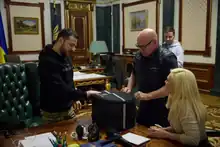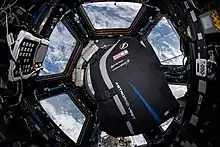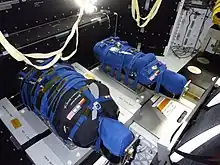 | |
| Industry | Personal protective equipment |
|---|---|
| Founded | 2011 |
| Founders | Oren Milstein and Daniel Levitt |
| Headquarters | |
| Website | www |
StemRad is an Israeli-American start-up company that develops and manufactures personal protective equipment (PPE) against ionizing radiation. Its first product was the 360 Gamma, a device that protects the user's pelvic bone marrow from gamma radiation.[1] StemRad has also developed the StemRad MD, a protective suit designed to provide whole-body radiation protection to physicians, and the AstroRad vest for radiation protection in space, which is currently being tested on the International Space Station and is one of the primary payloads onboard NASA's Artemis 1 lunar mission.[2][3][4]
History
StemRad was founded in December 2011 by Oren Milstein and Daniel Levitt. They were inspired to create the company by the Chernobyl disaster where many of the firemen and engineers, who were first on the scene, died from high doses of gamma radiation in an illness known as Acute Radiation Syndrome (ARS), also known as radiation sickness. This idea was fueled by a sense of urgency due to the growing nuclear threat on the state of Israel. Following the Fukushima Daiichi nuclear disaster in March 2011, the two partnered with Roger Kornberg, Aaron Ciechanover and Michael Levitt.[5]
Products
360 Gamma
The 360 Gamma is a 14 kg (31 lb) belt designed to protect the pelvic area against gamma radiation. It is meant to be worn by first responders (fire fighters, paramedics, police and the military), that would be exposed to radiation in the event of a nuclear emergency.[6][7][8] It does not attempt to protect the whole body of the wearer, but, rather, selectively protects the bone marrow-rich pelvic region.[8] It is offered as a solution for acute radiation syndrome (ARS),[9] a major component of which is bone marrow failure.[10]

In November 2022, as a precaution to the risk of a nuclear emergency during the 2022 Russian invasion of Ukraine brought about by Russian threats to use nuclear weapons and the continued shelling of the Zaporizhzhia Nuclear Power Plant, StemRad began donating 360 Gamma devices to Ukrainian first responders.[11][12][13]
AstroRad

AstroRad is personal protective equipment for astronauts to be worn beyond low Earth orbit which was co-developed by StemRad and Lockheed Martin.[14] AstroRad protects bone marrow to prevent acute radiation sickness but is further expanded to also protect the lungs, stomach, colon, breast and ovaries – organs that are particularly sensitive to the development of cancer due to chronic exposure to radiation.[15] The AstroRad vest is strongly effective in shielding astronauts from the solar energetic particles (SEP) released during solar storms. The functional shielding material is made of high-density polyethylene (HDPE), which is a hydrogenous compound (with a high ratio of electrons to neutrons) optimized for shielding against charged particle radiation like SEP, according to the Bethe-Bloch formula.[16][17]

As a test before its planned use in deep space, an AstroRad vest launched to the International Space Station (ISS) in low Earth orbit on November 2, 2019 aboard Cygnus NG-12 as part of the Comfort and Human Factors AstroRad Radiation Garment Evaluation (CHARGE) study. Four female astronauts wore the AstroRad vest in microgravity for variable durations during routine activities, providing feedback on ergonomics, range of motion, comfort and general user experience.[18] In addition, entrepreneur and former Israeli Air Force pilot Eytan Stibbe wore the AstroRad vest during Axiom Mission 1, a privately funded and operated crewed mission to the ISS, in April 2022.[19][20]

The AstroRad vest was also one of the primary payloads onboard NASA's Artemis 1 mission, which launched an uncrewed Orion spacecraft in a Moon-orbiting trajectory on November 16, 2022, as part of the Matroshka AstroRad Radiation Experiment (MARE), an international collaboration between the Israeli Space Agency, the German Aerospace Center, NASA, and Lockheed Martin.[21][22][23] Onboard the crew module were two female radiation dosimetry phantom torsos named Helga and Zohar, which measured radiation exposure throughout the body during the mission via both passive and active dosimeters distributed at sensitive and high stem cell-concentration tissues.[24] By comparing the dosimetry data from Helga and Zohar, the effectiveness of the AstoRad vest in shielding astronauts from radiation in deep space will be experimentally quantified.
StemRad MD
The StemRad MD is a protective system designed for interventional radiologists and other physicians who perform medical imaging using ionizing radiation, most notably fluoroscopy.[25] This technology was designed to increase whole-body protection, particularly to the head, while providing physicians relatively free-range motion capabilities while operating. For ergonomic relief, the StemRad MD system uses a proprietary exoskeleton system.[25]
The protective ensemble consists of four main parts: a protective apron, a protective visor, a thyroid collar, and an exoskeletal system. The protective apron is of bismuth-antimony bilayer composition and offers 0.5mm lead-equivalent protection with a small overlap area of 1mm in the front.[25][26] The visor is made up of a transparent lead-acrylic material. It is positioned at an angle so that it blocks most of the radiation coming from underneath and allows the physician to wear unshielded prescription glasses while performing procedures.[25] The thyroid collar is integrated into the protective apron component and is flush with the bottom side of the protective visor.[25]
References
- ↑ "The Belt That Protects Against Gamma Radiation". www.popularmechanics.com. Retrieved 27 August 2019.
- ↑ "New radiation vest technology protects astronauts, doctors". UPI. Retrieved 2022-12-06.
- ↑ "Israeli radiation protection vest blasts off to Int'l Space Station". The Jerusalem Post. November 3, 2019.
- ↑ Crane, Aimee (2020-02-13). "Orion "Passengers" on Artemis I to Test Radiation Vest for Deep Space". NASA. Retrieved 2022-11-29.
- ↑ "Dismantling the Bomb: meet the scientists that will cause humanity to stop worrying about nuclear threats". The Marker.
- ↑ "Stemrad Makes Belt to Protect Users From Radiation Exposure". Jewish Business News.
- ↑ "Israeli Company Invents Nuclear Proof Vest That Protects Against Toxic Radiation". The Algemeiner.
- 1 2 Radiation belt a new line of defence in nuclear emergency. Reuters
- ↑ "StemRad: Innovation in Radiation Protection". Israel Innovation Authority. Retrieved 28 August 2019.
- ↑ "Acute Radiation Syndrome: A Fact Sheet for Clinicians". Centers for Disease Control and Prevention. Retrieved 28 August 2019.
- ↑ Stebbins, Ashley Capoot, Jack. "Zelenskyy on Putin's threat of nuclear weapons: 'I don't think he's bluffing'". CNBC. Retrieved 2022-12-05.
{{cite web}}: CS1 maint: multiple names: authors list (link) - ↑ "Ukraine's Zaporizhzhya Nuclear Power Plant lost off-site power again, diesel generators providing back-up electricity". www.iaea.org. 2022-11-03. Retrieved 2022-12-05.
- ↑ "A meeting with representatives of the StemRad company and American astronaut Scott Kelly was held at the State Emergency Service". 2022-11-29.
- ↑ "Space Florida, Israel Innovation Authority Announce Sixth Round Winners of Innovation Partner Funding". Space Florida. Retrieved 27 August 2019.
- ↑ "Tissue weighting factors according to ICRP 103 (ICRP 2007)". European Commission. Retrieved 27 August 2019.
- ↑ AstroRad. European Space Agency. 25 January 2019.
- ↑ Gaza, Razvan. "International Science Aboard Orion EM-1: The Matroshka AstroRad Radiation Experiment (MARE) Payload" (PDF). nasa.gov. Retrieved 27 August 2019.
- ↑ "AstroRad on the ISS". The Embassy of Israel to the United States. Retrieved 27 August 2019.
- ↑ "Ax-1 Mission". CNBC.
- ↑ "AstroRad_Axiom1".
- ↑ "NASA Acting Administrator and Israel Space Agency Director General Sign Agreement". nasa.gov. Retrieved 27 August 2019.
- ↑ "Tracking cosmic radiation – To the Moon and back with ISA and NASA". dlr.de. Retrieved 27 August 2019.
- ↑ "DLR - Institute of Aerospace Medicine - MARE". www.dlr.de. Retrieved 2022-11-29.
- ↑ Gaza, R (2019). "Orion EM-1 Internal Environment Characterization: The Matroshka AstroRad Radiation Experiment" (PDF).
- 1 2 3 4 5 "StemRad MD".
- ↑ Büermann, L. (2016-09-06). "Determination of lead equivalent values according to IEC 61331-1:2014—Report and short guidelines for testing laboratories". Journal of Instrumentation. 11 (9): T09002. doi:10.1088/1748-0221/11/09/T09002. ISSN 1748-0221.